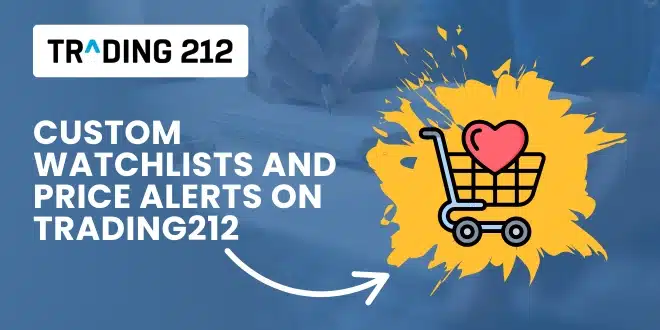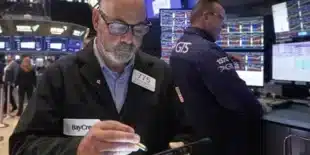Ever watched a stock move right after you stopped checking it? Or missed the perfect dip because you were stuck in a meeting? You’re not alone. That’s exactly why Trading212’s custom watchlists and price alerts exist — to help you stay in control of your trades without being glued to your screen.
These features aren’t just convenience tools — they’re decision tools. When used right, they help beginners and everyday traders stay focused, avoid distractions, and trade with more confidence.
Why watchlists and alerts matter more than you think
You can’t track everything, every second. But you also don’t want to miss opportunities. That’s the tension every trader feels — especially when you’re juggling work, school, or daily life.
That’s where these tools come in:
- Watchlists help you keep the assets you care about in one place
- Price alerts notify you the second something hits your target
Less screen time. More strategy.
And no, you don’t need to be an expert. In fact, these tools are perfect for beginners building discipline and learning how to plan.
What is a custom watchlist on Trading212?
Think of a watchlist as your personal radar. It’s a hand-picked collection of assets — stocks, ETFs, currencies, crypto — that you want to keep your eyes on. Watchlists on Trading212 show key info at a glance:
- Current price
- Daily percentage change
- Easy access to the buy/sell screen
And here’s the best part: you can have more than one. Set them up by:
- Investment type (stocks, crypto, ETFs)
- Risk level
- Trading strategy (long-term vs short-term)
- Sector (tech, energy, consumer goods)
One-sentence takeaway: Watchlists help you organize your attention — so you stop scrolling and start thinking clearly.
How to create and manage custom watchlists
Step-by-step setup:
- Tap the magnifying glass to search for an asset
- Tap the star icon to add it to your default watchlist
- Open the “Watchlists” tab from your homepage
- Tap “Create New Watchlist” and name it
- Add or remove assets anytime by tapping the star again
You can reorder assets, drag them around, or clean up your lists as your goals shift.
Pro Tip: Some users add emojis to their list titles (like 🔬 for biotech or 💡 for tech) to help spot them faster when managing multiple lists.
What is a price alert on Trading212?
A price alert is a notification that pops up when an asset hits a price you set. It’s like telling the app, “Tap me on the shoulder when this thing moves.” When you’re watching for:
- Entry points
- Profit targets
- Volatility spikes
- Support/resistance breaks
…alerts save you time, stress, and constant checking. They work for:
- Stocks
- ETFs
- Forex
- Cryptocurrencies
One-sentence takeaway: Alerts let you step away from the screen without losing track of your plan.
How to set price alerts (with step flow)
- Tap the asset you want to track
- Tap the bell icon
- Enter your price target (up or down)
- Confirm to save the alert
- You’ll get a push notification if the price hits your target
- You can manage alerts under the “Alerts” section in your account. Tap any alert to edit or delete.
Pro Tip: Set your alert slightly above or below your actual price goal — this gives you a heads-up before the price crosses your trigger point.
Watchlist vs Alert: When to use each
| Watchlists help you… | Price alerts help you… |
|---|---|
| Stay organized | Catch key price moments |
| Compare assets | Act without babysitting |
| Research trends | Time your trades |
Use both together for the best results: your watchlist is your plan, and alerts are your reminders to act.
How beginners and real traders use these tools
Let’s look at a few real examples of how traders use these in everyday situations:
- Anna, a beginner investor, has one watchlist for “learning” and one for “ready to buy.” It helps her separate research from action.
- Jamal, a crypto swing trader, uses alerts to recheck coins when they spike or drop 5%. He no longer chases prices — he waits for confirmation.
- Lina, a part-time trader, sets alerts during earnings season and uses a watchlist to track price reactions without watching charts all day.
From community feedback on Reddit and trading forums, users love the ease and speed of the alert system. Some advanced users wish for recurring or multi-trigger alerts, but the current tools cover most beginner and intermediate needs well.
Common mistakes to avoid
- Setting too many alerts at once — You’ll start ignoring them
- Using watchlists like shopping carts — Add only what you’re actually tracking
- Not enabling notifications — Go into phone settings and double-check
- Forgetting alerts are one-time only — You’ll need to reset them after they trigger
- Skipping the chart check — An alert is a reminder, not a trade signal
Advanced clarity: Alerts vs limit orders
This trips up a lot of beginners:
- Price alerts = notification only
- Limit orders = auto-trade execution at a set price
With alerts, you decide what to do when the price hits. With limit orders, the system trades for you. Alerts are great for cautious traders still learning to time their moves.
What if an alert triggers after hours?
If the market is closed when an alert triggers:
- You’ll still get notified
- You can act when the market opens again
- Nothing executes automatically
Also, alerts do not carry over into extended trading hours unless you’re trading assets that support that — and even then, it’s informational only.
Weekly workflow tip for smart use
Try this beginner-friendly routine:
- Monday: Check and update your watchlists
- Mid-week: Add alerts near earnings reports or economic news
- Friday: Clean up expired alerts and reflect on what triggered
- Weekend: Set goals and review price zones for the next week
This builds rhythm and keeps you engaged — without burning out.
Feature wish note from power users
Across community discussions, some active traders have suggested useful upgrades like:
- Recurring alerts that re-trigger
- Alert triggers by % change, not just price
- Multi-condition alerts (e.g. “price hits AND volume rises”)
While these aren’t available yet, Trading212 continues improving its feature set, and the current tools still serve most use cases well.
Final Thoughts
Custom watchlists and price alerts on Trading212 give you control without chaos. They help you think clearly, act intentionally, and trade with less emotion. Whether you’re learning to spot opportunities or timing your entries, these tools are here to serve you — not stress you out.
Keep your plan simple, your watchlist clean, and your alerts smart. You’re not here to react to every move — you’re here to trade with purpose.
FAQs
1. Can I create more than one watchlist on Trading212? Yes. You can create as many as you want and organize them by sector, goal, or risk level.
2. How do I remove an asset from a watchlist? Tap the star icon again to un-favorite it, or tap “Edit” inside the watchlist.
3. Can I set alerts for both rising and falling prices? Yes. Just enter the specific price you want to be notified about — up or down.
4. Do alerts execute trades automatically? No. Alerts only notify you. You still decide whether to place a trade.
5. Will I get an alert if the market is closed? Yes — but it’ll only trigger once trading resumes, depending on the asset.
6. Can I change or delete an alert after I set it? Absolutely. Go to the “Alerts” section and tap any alert to edit or remove it.
7. What if I miss a price alert? Alerts are one-time only. If you miss it, you’ll need to reset a new one.
8. Are alerts available on both mobile and desktop? Yes. Both platforms support alerts, but many users find the mobile app faster for setup.
9. What happens if an alert triggers briefly and reverses? You’ll still get the alert. It’s based on price hit, not how long it stays there.
10. Can I set alerts based on percentage change instead of price? Not yet — alerts are price-based only. But many traders calculate rough percentages themselves and set equivalent levels.


